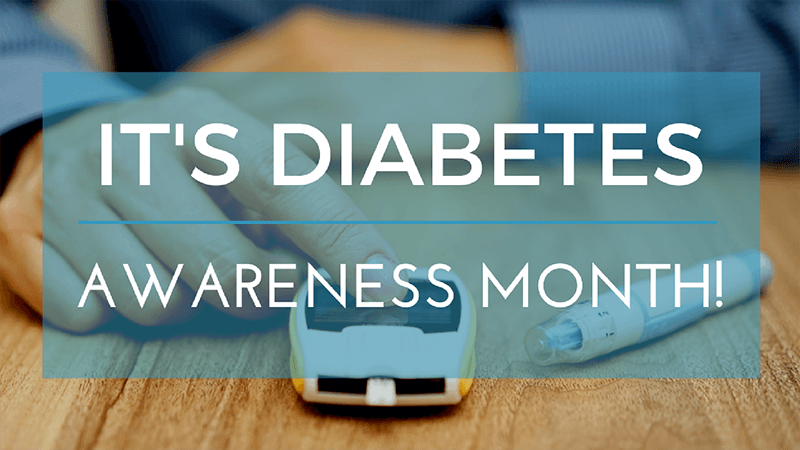Posted on November 8, 2016
It’s Diabetic Eye Disease Awareness Month!

November is a month we all equate with fall, the beginning of the holiday season, and of course, Thanksgiving. Aside from being the pinnacle of all things autumn, did you know that November is also Diabetic Eye Disease Awareness month? If you’re an ophthalmologist, the answer is probably yes. If not, let’s take some time to learn a little bit about these common diseases and spread some awareness!
Being diabetic, no matter the type, can mean having to make big changes to the way you live your life. It can also mean dealing with a lot of diabetes-related illnesses. When it comes to eyesight, diabetic eye diseases are nothing to mess around with! Diabetes requires constant monitoring, and it’s essential that your eyes get the same attention to avoid diseases like diabetic retinopathy, diabetic macular edema, cataracts and glaucoma.
Diabetic Retinopathy
Diabetic retinopathy is a condition that affects the retina and its tiny blood vessels. For people with diabetes, diabetic retinopathy is the number one cause of vision loss. Those with diabetes often suffer from persistent high blood sugar, which can cause damage to the retina’s fragile blood vessels. The retina’s blood vessels will begin to leak into the eye, causing gradual vision loss.
Diabetic retinopathy has four stages: mild, moderate, severe, and proliferative retinopathy. Diabetic retinopathy will usually start off with microaneurysms, causing the blood vessels in the eye to leak a small amount of fluid into the eye cavity. As diabetic retinopathy progresses, patients will notice vision distortion and “floaters” in their visual field. The final stage is called proliferative retinopathy. New, abnormal blood vessels begin growing at a rapid pace on the retina. These new blood vessels are extremely fragile, and leak a large amount of fluid into the eye. This ultimately leads to a large amount of vision loss and possible blindness.
Diabetic Macular Edema (DME)
Diabetic Macular Edema develops in about half of diabetic retinopathy sufferers, causing blurred vision. Persistent high blood sugar leads to diabetic retinopathy, which can lead to DME. When the fluid leaks from blood vessels as a result of diabetic retinopathy, there’s a chance that the fluid could get underneath the retina. From here, there is a possibility of retinal detachment, as the fluid lifts the retina from the wall of the eye.
Diabetic retinopathy and DME often go hand in hand. To monitor the development of these disorders, diabetic patients should have a comprehensive dilated eye exam at least once a year. Keeping up to date on these exams makes it easy for eye doctors to keep an eye on anything that may look suspicious. DME can be treated in a number of ways, including Anti-VEGF injection therapy, macular laser surgery, and corticosteroids. These treatments can be used concurrently in some cases, depending on the severity of a patient’s diabetic macular edema.
Cataracts
Although cataracts are a pretty typical occurrence for the aging population, for people with diabetes, cataracts could occur much earlier in life. Because of the spikes in blood sugar levels that diabetics often deal with, cataracts can develop anywhere between 20 and 70 years of age.
The best way to monitor cataract development is to get regular eye exams from an ophthalmologist. To prevent diabetes related cataracts, make sure your blood sugar is well controlled. The only way to treat cataracts is with surgery, where the cloudy lens is replaced with an artificial lens. Left untreated, cataracts can lead to cloudy vision along with increased glare, making driving difficult or almost impossible at night.
Glaucoma
People with diabetes are twice as likely to develop glaucoma. You may not realize that you have glaucoma at first. The most common type of glaucoma shows no symptoms until vision loss occurs.
Glaucoma occurs when pressure builds up in the eye. This pressure is referred to as “intraocular pressure”. This increase in pressure causes damage to the optic nerve. Once vision is lost to glaucoma, it is irreversible. If caught quickly at yearly eye exams, glaucoma in diabetics can be treated with special eye drops designed to lower intraocular pressure. Along with yearly eye exams with an ophthalmologist, the best way to prevent glaucoma is to keep your diabetes under control through constant monitoring of insulin and blood sugar levels.
Make sure to visit your eye doctor as directed to ensure great eye health! If you or someone you love has been diagnosed with diabetes, or if you simply want to spread awareness, share this article!
